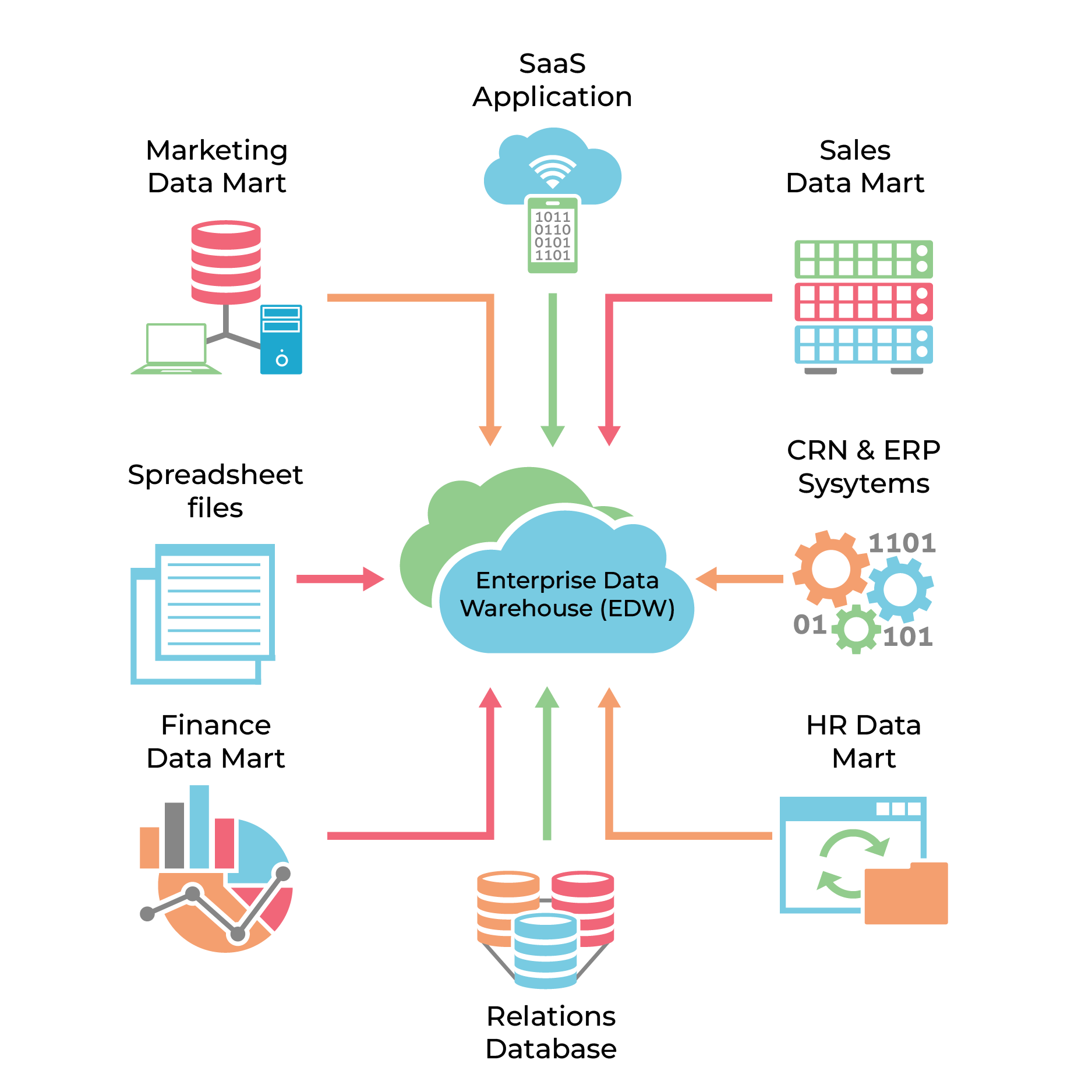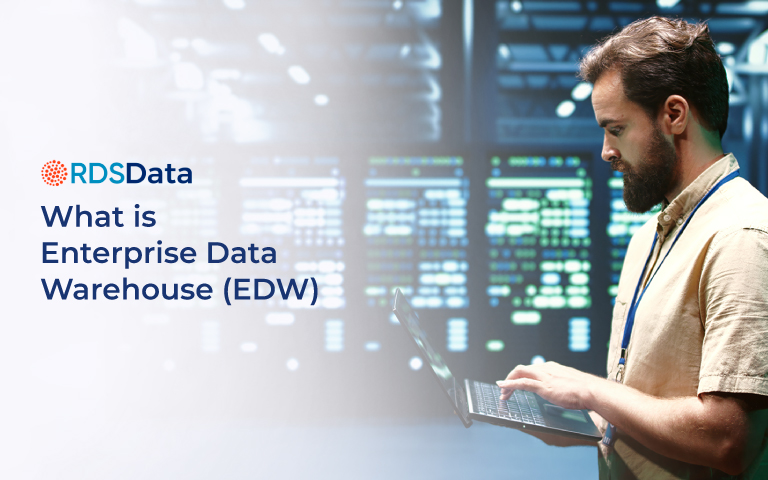High-growth enterprises eventually reach a point where decisions can no longer be made on spreadsheets, departmental exports, or fragmented dashboards. When numbers differ across teams, when audits get delayed because data is scattered, and when AI or predictive analytics projects fail due to inconsistent inputs, leadership realizes something is structurally wrong with how data is stored, governed, and consumed.
More than 65–70% of large organisations are actively modernising their data warehousing layer to support board reporting, AI governance, compliance, and strategic forecasting. At the same time, analysts estimate that over half of AI failures are linked not to models, but to poor data foundation, especially a lack of a reliable enterprise data warehouse architecture.
This guide will help enterprises that are already feeling the business pressure of scattered data and want clarity. It is a complete guide on what an Enterprise Data Warehouse (EDW) is, why it exists, and how mature companies use it to ensure data integrity, auditability, and decision confidence at scale.
What is an Enterprise Data Warehouse (EDW)?
An Enterprise Data Warehouse (EDW) is a centralised repository that consolidates data from multiple sources, ERP, CRM, SaaS platforms, transactional systems, partner feeds, and external datasets and standardises it into a governed, query-ready, auditable environment for enterprise reporting, AI, and analytics.
Unlike operational databases that are built for transactions, an EDW is built for analysis, governance, lineage, and decision-support. It enforces data models, applies data integration rules, runs ETL / ELT processing, and ensures that every executive report is generated from consistent, reconciled, and trusted data.
So, if an enterprise wants leadership, regulators, and investors to trust the numbers, the EDW is the layer that ensures data is correct before it is consumed.
Inputs That Feed an EDW

EDWs integrate data from multiple sources, but not arbitrarily. Inputs must be stable, governed, explainable, permission-safe, and economically justified.
Primary Classes of EDW Inputs
- Transactional Systems: ERP, CRM, Billing, Claims, Core Banking, MES, HCM
- Digital Exhaust: Clickstream, app telemetry, IoT signals, product journeys
- Commercial External Feeds: Syndicated market data, bureau data, regulatory lists
- Semi-structured / Unstructured: Contracts, ESG filings, emails, PDF disclosures
- Strategic Web-collected Intelligence: Competitor catalogues, supplier signals, tenders, policy movement
- Cloud-based Application Logs: Security events, API usage, SOC telemetry
Well-formed EDWs do not start from tables; they start from source legitimacy. Inputs chosen decide whether the EDW becomes a reporting layer or a strategic advantage engine.
Why Enterprises Build EDWs?
Enterprises do not build EDWs out of curiosity. They do it when risk or complexity crosses a threshold. Some of the most common triggers are:
1) Fragmented data leading to conflicting KPIs
Sales, finance, BI, and supply team all present different figures, a classic “data truth crisis”.
2) Compliance, audit, and accountability pressures
Industries under SOX, GDPR, HIPAA, PCI-DSS, or banking regulations must have traceable, standardised, and historised data.
3) M&A, multi-entity consolidation, or global expansion
When data from subsidiaries, countries, or brands needs unified governance, EDW becomes mandatory.
4) AI / ML and predictive planning readiness
No enterprise AI works reliably without clean, standardised, high-performance data pipelines, and EDW is often the governing backbone.
5) Reducing redundancy and manual effort
Without EDW, each team builds its own shadow databases, extracts the same raw feeds, and duplicates integration cost endlessly.
6) Leadership push for decision assurance
Board members, investors, and CFOs increasingly demand audit-ready, explainable, and defensible numbers, not stitched-together exports.
Core Components of an EDW
An Enterprise Data Warehouse is not a single box; it is a stack of engineered functions guaranteeing trust, timeliness, and explainability at scale. A EDW typically contains:
Ingestion Layer: Pulls data from multiple sources in batch or real-time, without breaking upstream systems.
ETL / ELT Processing: Performs cleansing, validation, standardisation and data integration before storage.
Centralized Repository: Columnar, governed storage for enterprise data warehouse architecture (cloud or on-prem).
Semantic / Data Models: Converts raw tables into business-portable, governed data models and data marts.
Access & Delivery Layer: APIs, BI, ML feeds, self-serve analytics with role control.
Data Governance & Security: Lineage, PII policy, retention rules, audit-proof controls.
These components together ensure data is correct, consistent and board-defensible, not merely collected.
EDW vs Data Lake vs Lakehouse
Executives do not compare tech for syntax; they compare risk, time-to-decision, and defensibility.
| Dimension | Enterprise Data Warehouse (EDW) | Data Lake | Lakehouse |
|---|---|---|---|
| Nature | Curated, structured data stored | Raw, uncurated big data | Hybrid curated-on-lake |
| Truth Quality | High — audit-ready | Low — needs refinement | Medium–High |
| Speed-to-Insight | Fast for known questions | Slow (engineering-heavy) | Balanced |
| Governance | Mature and strict | Minimal by default | Emerging / mixed |
| Executive Use | Financial & regulated truth | Exploration & science | Unified cost / reuse play |
| Cost Posture | Higher but predictable | Cheap to ingest, expensive to use later | Middle band |
Architecture Choices
Architecture is not an engineering decision; it is a risk-capital allocation decision. Boards ask one question first: “What failure are we trying to make impossible?” EDW architectures are shaped by that answer, not by vendor logos.
- Cloud-based vs On-prem vs Hybrid – cloud reduces capex but raises jurisdiction and lock-in risk
- Centralized vs Federated Models – centralized improves control, federated reduces political friction
- Batch vs Real-Time Pipelines – real-time increases cost but protects time-sensitive value windows
- Single EDW vs EDW + Data Marts Layer – marts reduce blast radius and latency
Boards approve EDW architectures that minimise regret, not that maximise technology novelty.
Common Use-Cases of EDW Investments
EDW is essential when P&L, regulatory, or competitive pressure is explicit. Adoption today is rarely “modernisation for dignity”; it is “modernisation to prevent harm or capture unfair edge.”
Typical Investment-Trigger Use-Cases
- Regulatory Exposure: SOX, Basel, IFRS, HIPAA, ESG disclosures must run on governed truth
- Margin Protection: Pricing, procurement, and leakage analysis need certified warehouse logic
- Board-level KPIs: Single, dispute-free metrics across countries/entities
- M&A Integration: Unify post-merger systems without rewriting all upstream apps
- AI / Forecast Quality: Models need de-duplicated, time-aligned supervisory data
- Customer Risk & Churn: Defensible signals stitched across silos
If any of the above exist, EDW is not technology; it is insurance against mis-led decisions.
EDW Planning & Execution
Real implementations are never linear. EDW programmes that succeed are those treated as governance change before technology deployment.
Stage 1: Mandate & Scope
Define “non-negotiable truths” before drawing boxes and arrows.
Stage 2: Source Contracts & Access
Failures typically start here — without upstream guarantees, the rest is theatre.
Stage 3: Architecture Freeze & Pipeline Design
Lock risk posture before writing ingestion code.
Stage 4: Incremental Delivery via Data Marts
Go live on governed slivers, not ideal end-state diagrams.
Stage 5: Governance & Measurement Hardening
Lineage, SLA breach policies, and KPI attestation come before self-service rollout.
Enterprises that delay governance until after build convert EDWs into expensive storage rather than a trusted decision infrastructure.
Risks, Failure Patterns & Prevention
Most EDW failures are not technical, but they are behavioural and structural. Enterprises usually fail when they treat EDW like an IT build rather than a trust-infrastructure mandate. The biggest failure patterns are predictable:
Observed Patterns of Failure
- Scope Creep without Executive Triage — trying to solve every question in release-1
- No Enforcement on Source Quality — bad input guarantees a bad warehouse
- Architecture Designed by Tools, Not Risk — vendor-led, not outcome-led decisions
- Governance Deferred to “Later” — lineage and controls bolted on post-build
- Lack of KPI Ownership — analysts rewrite numbers outside the warehouse
Prevented When Does the Following
- Fixes “what truths will be notarised” before design
- Forces upstream quality contracts and SLAs
- Approves architecture based on risk & audit, not hype
- Measures adoption of governed truth, not dashboard count
- Protects the scope and sequence from stakeholder noise
- Intervention early is cheaper than remediation late.
Success Metrics Executives Use to Measure EDW ROI
C-suites do not measure EDW by tables or jobs; they measure by reduction in argument, risk, and cycle time to a valid decision.
Visible ROI Signals
- Time-to-Decision Compression — months → weeks → days for investor-critical questions
- Dispute Reduction Across Functions — one KPI truth accepted without reconciliation calls
- Audit / Regulatory Pass Rates — fewer findings, lower remediation spend
- Model Quality Uplift — AI/forecast error deltas shrink due to governed inputs
- Reusability of Data Assets — new use-cases launch without new pipelines
- Cost-to-Insight Drop — less analyst labour to clean, reconcile, and re-prove data
Return is realised not when EDW “runs”, but when decisions stop being courage-based and become evidence-anchored.
RDS Data: Your Web Data Extraction Partner
Many EDW programmes require external, web-origin data to complete competitive or compliance context, such as supplier catalogues, regulatory disclosures, or market signals that never exist inside internal systems.
In such cases, RDS Data becomes your long-term web data extraction partner to supply structured, stable, and compliant streams of external intelligence that can feed the EDW without burdening internal engineering or risking governance breach.
Our partnership approach ensures continuity, deduplication logic, SLA discipline, and defensible lineage for web-derived inputs, which is critical when that data becomes part of board-visible decisions.
Key Takeaways
- EDW is a governance and decision-risk instrument, not merely storage
- Architecture must be chosen based on risk posture, not tooling fashion
- Inputs define destiny; bad upstream is unrecoverable downstream
- Adoption is the true ROI; truth must replace argument
- EDW + Lake/Lakehouse is coexistence, not replacement
Tired of broken scrapers and messy data?
Let us handle the complexity while you focus on insights.

